 ©
Fifth Third Bank | All Rights Reserved
Exhibit 99.1
Citi Financial Services Conference
Kevin T. Kabat
President & Chief Executive Officer
March 9, 2011
Please refer to earnings release dated January 19, 2011 and
10-K dated February 28, 2011 for further information
|
 2
©
Fifth Third Bank | All Rights Reserved
Key themes
Well-positioned for success and leadership in new banking landscape
Return to solid profitability
in 2010, broad-based credit
improvements, exceed fully
phased-in Basel III capital
standards today
Completely exited all
crisis-era government
support programs, one of
the few large banks without
TLGP-guaranteed debt
Continued investments in
business throughout crisis
to maintain and enhance
revenue-generating
capability
No significant business at
Fifth Third impaired during
crisis; traditional banking
focus consistent with
direction of financial reform |
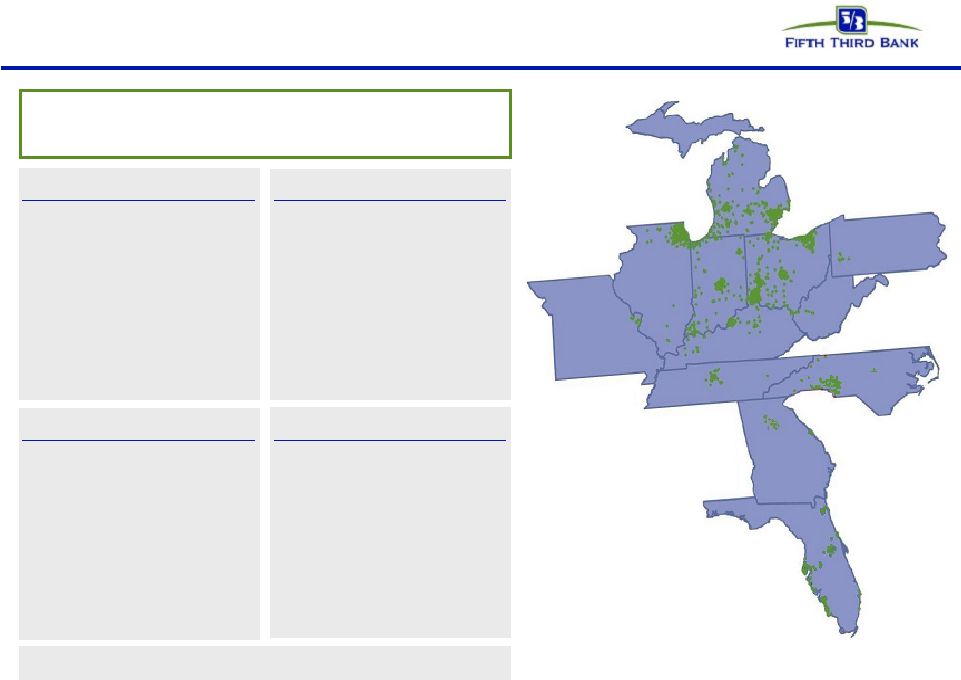 3
©
Fifth Third Bank | All Rights Reserved
Fifth Third franchise
Naples
Kentucky
Tennessee
Georgia
Florida
North
Carolina
West
Virginia
Pennsylvania
Ohio
Michigan
Illinois
Indiana
Missouri
Branch Banking
Consumer Lending
Commercial Banking
Investment Advisors
•
$1.1bn total revenue
•
$20.5bn average loans
•
$65.6bn mortgage servicing
portfolio
•
7,700 dealer indirect auto lending
network
•
Top 5 market share leader within
the non-captive prime auto
lending space
•
$69mm credit interchange
revenue
•
1,312 full-service banking centers
•
2,445 full-service ATMs
•
$2.4bn total revenue
•
$17.8bn average loans
•
$44.6bn average core deposits
•
1.5mm online banking customers
•
$204mm debit interchange
revenue
•
$2.2bn total revenue
•
$38.4bn average loans
•
$24.2bn average core deposits
•
1,350 large corporate client
relationships
•
18,500 middle market client
relationships
•
236,500 treasury management
lead accounts
•
$494mm total revenue
•
$2.6bn average loans
•
$5.9bn average core deposits
•
$25bn assets under management
•
$266bn assets under care
Headquartered in Cincinnati, Ohio with 15 affiliates
across the Midwest and Southeast United States
•
49% interest in Fifth Third Processing Solutions, LLC
|
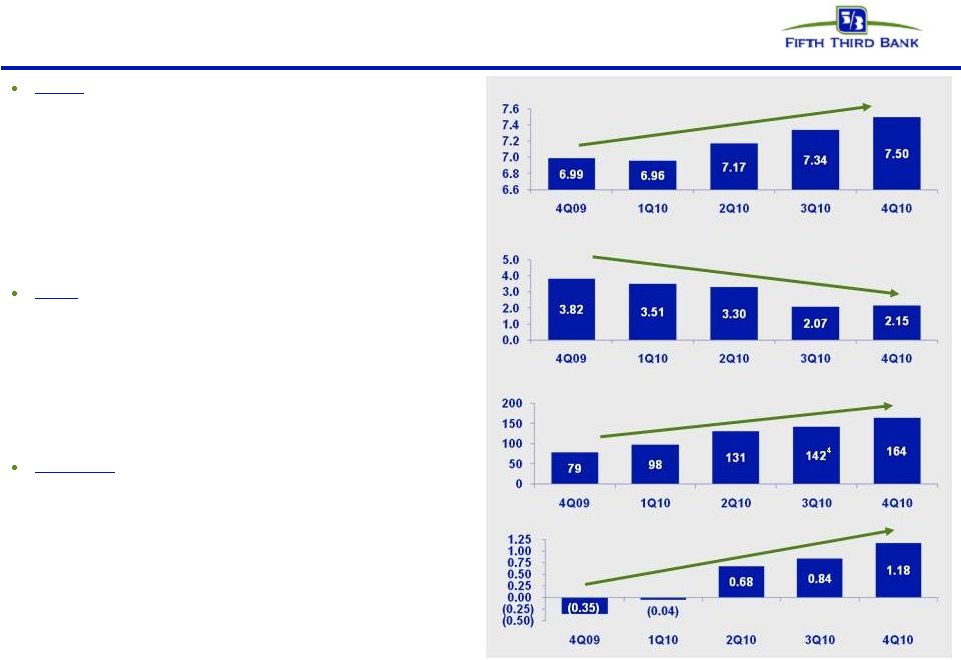 4
©
Fifth Third Bank | All Rights Reserved
A foundation of continued growth
Capital
–
foundation for continued growth
—
Tier
1
common
capital
has
increased
313bps
or
$2.6bn
1
—
Capital base transformed through series of capital actions
–
9.4% pro forma Tier 1 ratio excluding trust preferred
securities to be phased-out beginning 2013
—
Capital levels supplemented by strong reserve levels
–
Loan loss reserves 3.88% of loans and 179% of NPLs
—
9.0% pro forma Tier 1 common ratio is $1.0bn in excess of
internal 8.0% target
Credit
–
ongoing discipline driving steady improvement
—
Broad-based improvements in problem loans
–
72% reduction in 90+ day delinquent loans since 3Q09
–
NCO ratio of 1.86%, first time below 2.0% since 2Q08
–
164%
PPNR
2
/
NCOs
in
4Q10
—
Balance sheet risk lowered through asset sales, resolutions
–
$1.3bn (43%) decline in NPLs since 4Q09
Profitability
–
recent results support positive momentum
—
PPNR remained stable throughout cycle
—
5 consecutive quarters of increasing earnings with 3 consecutive
profitable quarters
—
Return on assets 1.18%; Return on average common equity
10.4% in 4Q10
1
Since December 31, 2008
2
Pre-provision net revenue (PPNR): net interest income plus noninterest income
minus noninterest expense
3
Nonperforming
loans
and
leases
as
a
percent
of
portfolio
loans,
leases
and
other
assets,
including other real estate owned (excludes nonaccrual loans
held-for-sale) 4
Excluding $510mm net charge-offs attributable to credit actions and $127mm in
net BOLI settlement gains
Tier 1 common ratio (%)
NPL / Loans
3
(%)
PPNR / Net charge-offs (%)
Return on assets (%)
4 |
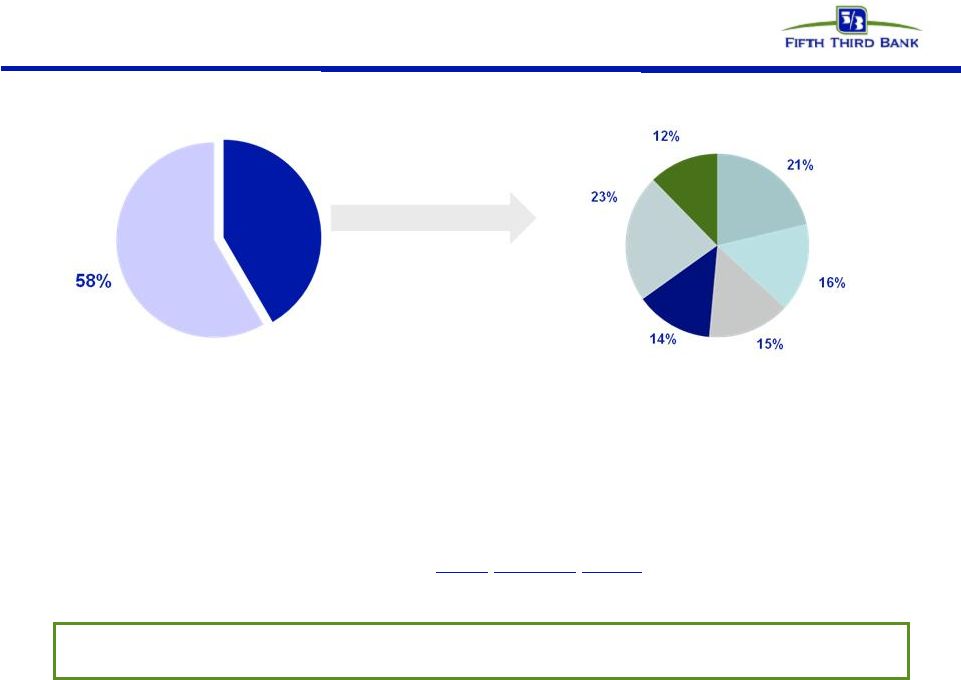 5
©
Fifth Third Bank | All Rights Reserved
Diverse revenue stream
•
Improving economy supportive of underlying revenue growth from loan growth and
business fee income –
Higher market interest rates in future should add further benefit
•
Negative impact of Reg E fully absorbed into results in 4Q10
•
Timing and initial impact of debit interchange legislation currently unknown
–
Legislative changes possible
–
Timing of implementation 2H11, unless timeline altered
–
~3%
of
revenue
at
risk
from
initial
impact
before
mitigating
actions
–
Valuable product and service; expect to mitigate through adjustments to product and
service offerings Deposit fees
Corporate
banking
Investment
advisors
Other
Mortgage
Card & Processing
42% Fee income
NII
Fee income as % of 2010 revenue
4Q10 Fee income distribution
Economic trends should support long-term improvement in results through
balance sheet growth and higher business activity |
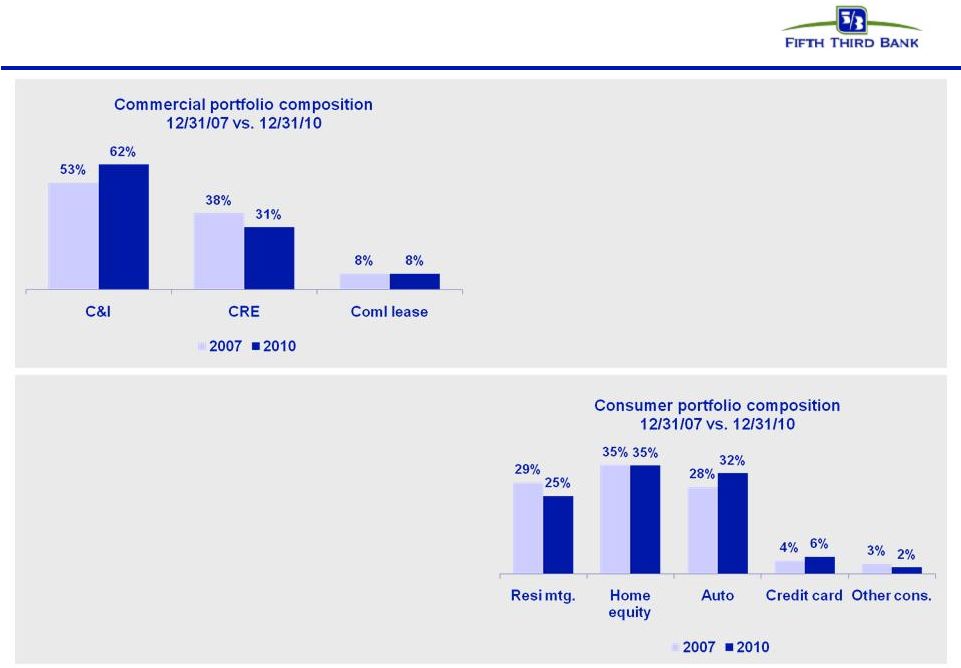 6
©
Fifth Third Bank | All Rights Reserved
Shift to higher quality average loan balances
•
Average commercial loan balances 56% of loans in 4Q10
•
Suspended homebuilder and developer lending in 4Q07 and
commercial non-owner occupied real estate lending in 2Q08
–
CRE loans represented only 17% of total loan portfolio
–
CRE portfolio balances 31% in 4Q10 vs. 38% in 4Q07,
decreased 23% or $3.9bn
•
Sold or transferred to held-for-sale $1.3bn of CRE loans in
4Q08 and transferred $961mm of commercial loans to held-
for-sale in 3Q10 (majority sold in 4Q10)
•
C&I loans represented 62% of commercial loans and grew 7%
sequentially in 4Q10*
•
Average consumer loan balances 44% of loans in 4Q10
•
Discontinued origination of brokered home equity products
at the end of 2007
•
Sold $228mm of mostly non-performing residential mortgage
loans in 3Q10
•
Top 5 market share leader within the non-captive prime auto
lending space
•
Began retaining branch-originated and shorter-term
mortgages in 3Q10
Note: Balances exclude loans held-for-sale
* Excludes impact of Fifth Third Processing Solutions, LLC loan refinancing in
4Q10 |
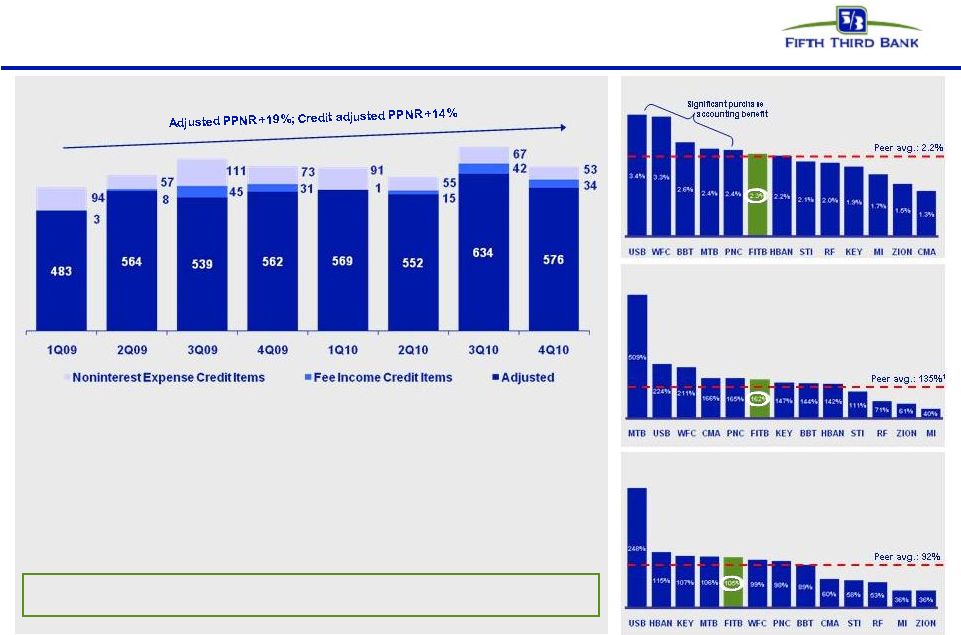 7
©
Fifth Third Bank | All Rights Reserved
Strong pre-provision net revenue
Core PPNR trend
Pre-provision net revenue (PPNR): net interest income plus noninterest income
minus noninterest expense; refer to appendix for reconciliation Source: SNL
Financial and company reports. Data as of 4Q10. •
Reported PPNR of $583mm down 34% from strong 3Q10 levels, which
included higher mortgage banking revenue, and up 4% over prior year
•
Adjusted PPNR of $576mm, due to adjustments totaling ($7mm),
resulting in sequential decrease of 9% and year-over-year increase of
2%
•
Excluding the impact of credit-related adjustments ($87mm in 4Q10),
PPNR down 11% versus 3Q10; stable versus 4Q09
Robust profitability provides strong loss absorption
Core PPNR / Risk-weighted assets
Core PPNR / Net charge-offs
Core PPNR / HFI Nonperforming assets
2
1
Peer
average
excludes
MTB
2
NPAs exclude covered assets for BBT, USB, ZION
* |
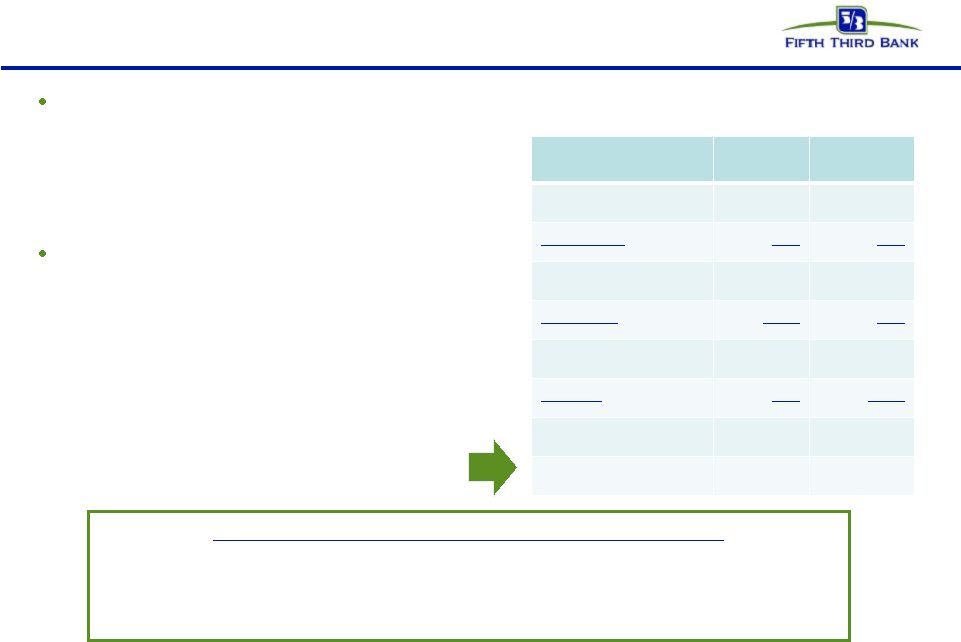 8
©
Fifth Third Bank | All Rights Reserved
ROAA upside remains
Fourth quarter ROA of 1.18% included
—
Provision expense / average loans
of 87 bps
—
$87mm of credit-related costs in
revenue and expense
Elevated credit costs should decline as
conditions normalize
—
Credit-related costs historically of
~$25mm (pre-credit crisis)
—
1997-2006 Average Provision /
Loans of ~50 bps (45 bps average
net charge-off ratio)
—
4Q10 results and historical average
credit results would produce an
ROAA of approximately 1.4%
Long-term target of 1.30 –
1.50% Return on Assets
Earning Asset growth
Mid-50% efficiency ratio
NIM of 3.5-4.0%
Provision of 40-60 bps
Fees / Revenue ~40%
Mitigation of financial reform
4Q10
Actual
4Q10
Illustrative
PPNR ex-credit costs*
$670
$670
Credit costs
(87)
(25)
Reported PPNR
583
645
Provision**
(166)
(95)
Pre-tax income
417
550
Taxes***
(84)
(165)
Net Income
333
385
ROAA
1.18%
1.37%
Illustrative ROA calculation using
historical NCO and credit-related costs
* PPNR before inclusion of credit costs
** Illustrative provision calculated using 50 bps historical average provision /
loan ratio *** Assumed effective tax rate of ~30%
|
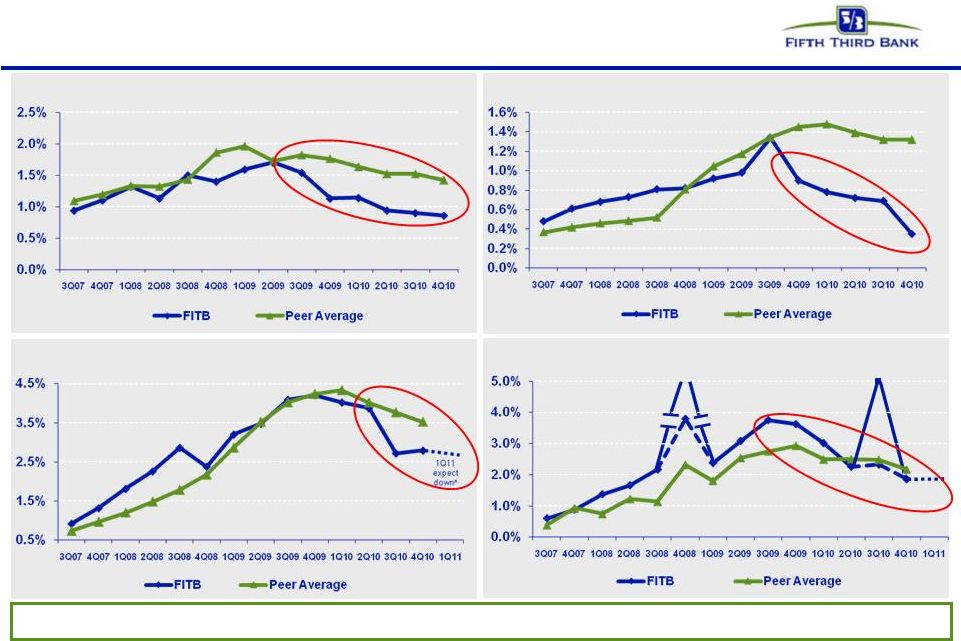 Strong
relative credit trends FITB problem credit metrics have moved below peer
levels HFI NPA ratio vs. peers
Net charge-off ratio vs. peers
Loans 90+ days delinquent % vs. peers
Loans 30-89 days delinquent % vs. peers
(7.5%)*(HFS transfer)
5.0%
9
©
Fifth Third Bank | All Rights Reserved
Source: SNL Financial and company filings. Peers include: BBT, CMA, HBAN, KEY, MI, MTB, PNC, RF, STI,
USB, WFC, and ZION. NPA and NCO ratios exclude loans held-for-sale and covered assets
for peers where appropriate.. * 4Q08 NCOs included $800mm in NCOs related to commercial
loans moved to held-for-sale; 3Q10 NCOs included $510mm in NCOs related to loans sold or moved to held-for-sale
^ Expected as of January 19, 2011
3.8%
Before credit
actions
2.3%*
Before credit
actions
1Q11
expect
stable^ |
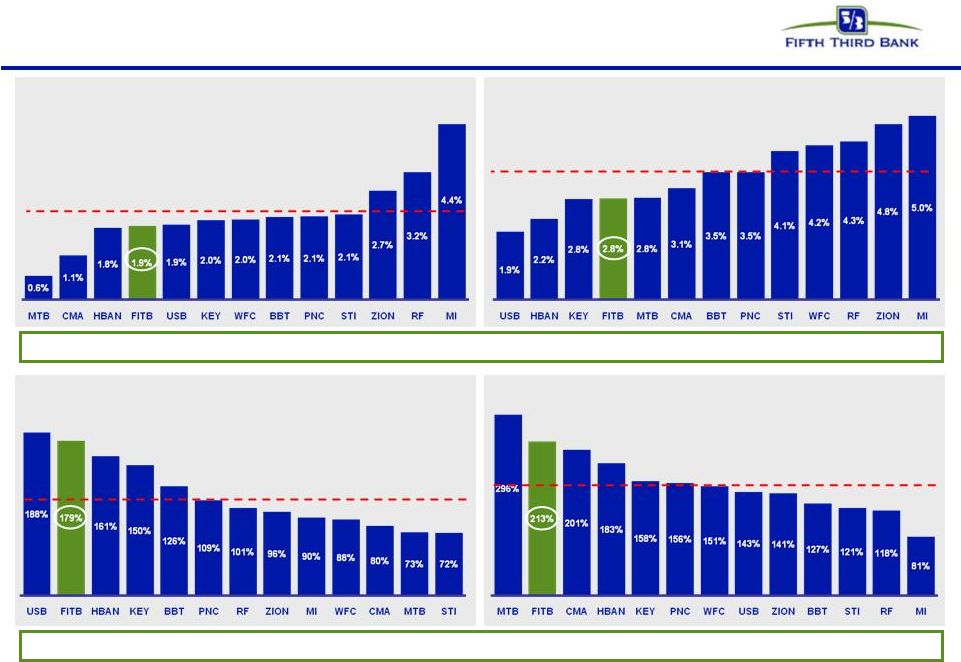 Credit metrics & reserve coverage outperform peers
HFI NPA
Ratio
Net Charge-off Ratio (Annualized)
Reserve coverage strong relative to problem assets and losses
Peer average: 2.2%
Peer average: 3.5%
Reserves / NPLs
Peer average: 111%
Reserves / Net Charge-offs (Annualized)
Peer average: 156%
FITB credit metrics lower than peers and represent position of relative
strength 10
©
Fifth Third Bank | All Rights Reserved
Source: SNL Financial and company reports. Data as of 4Q10. HFI NPAs and NPLs exclude loans
held-for-sale and also exclude covered assets for BBT, USB, and ZION |
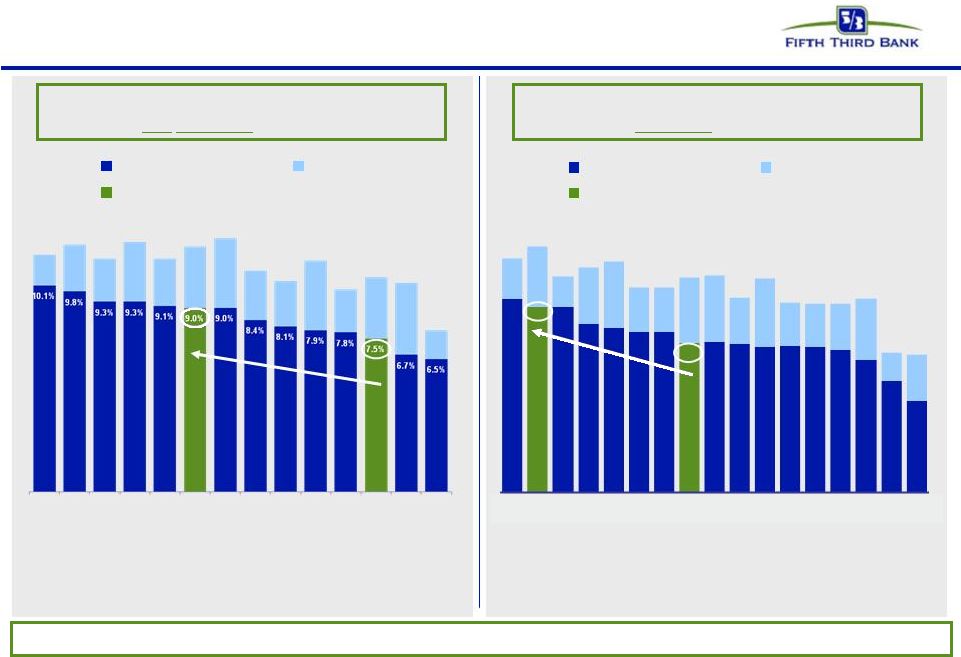 Strong pro forma capital position
Fifth Third’s capital position will be well in excess of any established
standards and most peers Red: repaid TARP
Tier 1 common (peers)
Tier 1 common (FITB)
Reserves
(Tier 1 common + reserves) / RWA
(not
adjusted
for Basel III)
11.6%
12.1%
11.4%
12.2%
12.0%
12.4%
11.4%
10.3%
11.3%
9.9%
10.5%
10.2%
7.9%
10.8%
CMA PNC
KEY HBAN BBT PF ZION WFC STI
RF USB
FITB MI MTB
FITB¹
Bank PF Bank Bank
Bank Bank Bank FITB Bank Bank Bank Bank Bank Bank Bank Bank Bank
1 FITB²
2
3 4 5 6
7
8 9 10 11 12
13 14
15 12.3%
9.3%
7.5%
10.7%
Peers not in order of graph at left; estimated
(Tier 1 common + reserves) / RWA
(adjusted
for Basel III)
Note: Estimates
based
on
current
Basel
III
rules
released
by
the
Basel
Committee,
not
adjusted for potential mitigation efforts. Four large peers include estimated
Basel III RWA impact based on BIS proposals
2
Pro forma for TARP redemption and issuance of $1.7bn of common equity net of
associated items, and phase-out of trust-preferred securities
1
Pro forma for TARP redemption and issuance of $1.7bn of common equity net of
associated items.
Reserves
Tier 1 common (peers)
Tier 1 common (FITB)
Source: SNL Financial, company filings, and third-party estimates. Regulatory financial data as of
4Q10. Common equity ratios for non-TARP repayers exclude discount accretion from attribution
of TARP value. Refer to Regulation G Non-GAAP Reconciliation in appendix.
11
©
Fifth Third Bank | All Rights Reserved |
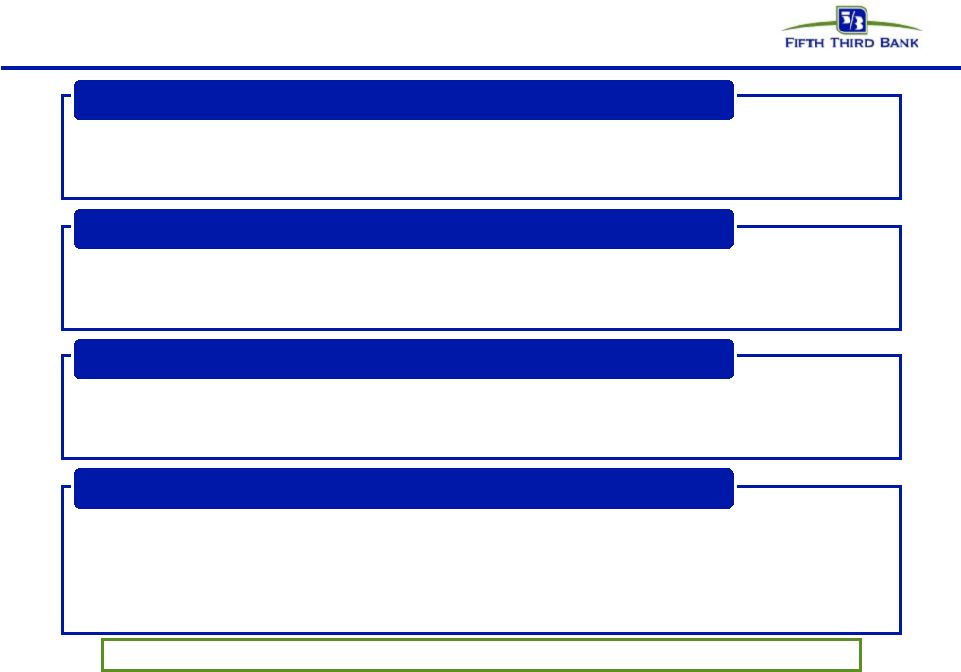 12
©
Fifth Third Bank | All Rights Reserved
Capital management philosophy
•
Return excess capital to shareholders after assessment of other capital deployment
alternatives and maintenance of buffers over targeted and required capital
levels •
Evaluate any share repurchases in context of stock price level
•
Not expected in near term
Share repurchases*
•
Prudently expand franchise or increase density in core markets via disciplined
acquisitions or de novos •
Attain top 3 market position in 65% of markets or more
Strategic opportunities*
•
Strong levels of profitability would support significantly higher dividend than
current dividend •
Subject to consideration and approval of plans submitted under CCPR**
Return to more normal dividend policy*
•
Support growth of core banking franchise
•
Improving loan demand in recovering economy
Organic growth opportunities
* Subject to Board of Directors and regulatory approval
** Comprehensive Capital Plan Review by Federal Reserve
Internal Tier 1 common equity target of 8% range |
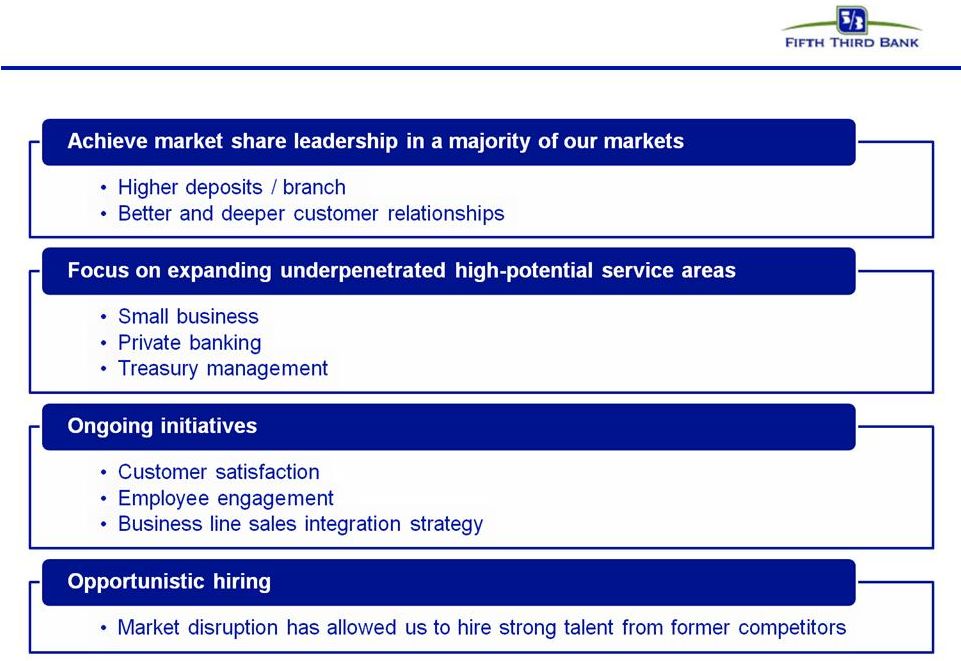 Continuing to invest for the future
13
©
Fifth Third Bank | All Rights Reserved |
 14
©
Fifth Third Bank | All Rights Reserved
Customer-centric traditional banking model:
well-positioned for changed financial landscape
Fifth Third’s business model is driven by traditional banking activities
—
Largest bank headquartered within Fifth Third’s core Midwest footprint
—
Focus on expansion and development of businesses where regional leadership
matters –
Retail, small business, and mid-market commercial
–
Select national lines where the bank has a distinctive element (i.e., Fifth Third
Processing Solutions, Indirect Auto, Healthcare)
—
Didn’t / don’t originate or sell CDOs or securitize loans on behalf of
others; no mortgage securitizations outstanding (except ~$120mm HELOC from
2003) —
Didn’t / don’t originate or sell subprime mortgages or Option ARMs
—
Low level of financial system “interconnectedness”
(e.g., Fifth Third loss in Lehman
bankruptcy should be less than $2mm)
—
Little to no impact from Volcker rule (de minimis market maker in derivatives,
proprietary trading); daily VaR less than $500 thousand
–
Small private equity portfolio ~$100mm (holding company subsidiary)
Fifth Third’s businesses have performed well through the crisis -
expect reintermediation
and the landscape to evolve further toward our traditional strengths
No significant business at Fifth Third impaired during crisis; traditional banking
focus consistent with direction of financial reform
|
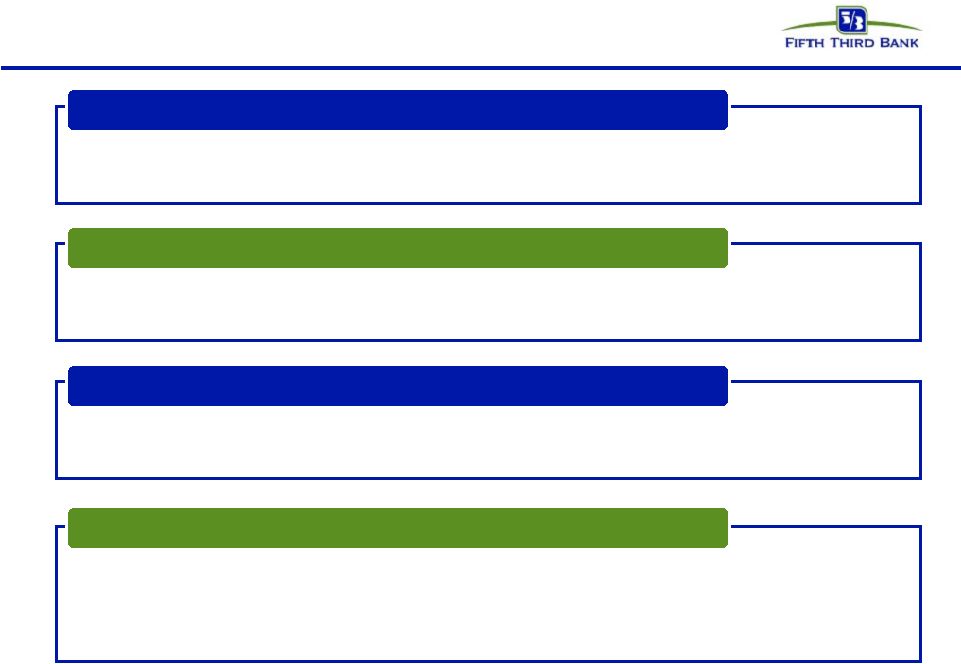 15
©
Fifth Third Bank | All Rights Reserved
Well-positioned for the future
•
Holding company cash currently sufficient for more than two years of obligations;
no holding company or Bank debt maturities until 2013
•
Bank level capital ratios significantly above most peers
•
After TARP repayment, Fifth Third has completely exited all crisis-era
government support programs –
Fifth Third is one of the few large banks that have no TLGP-guaranteed
debt Superior capital and liquidity position
•
$1.2bn problem assets addressed through loan sales and transfer to HFS in
3Q10 •
NCOs
less
than
2%
of
average
loans
(annualized);
213%
reserves
/
annualized
NCOs
•
Substantial reduction in exposure to CRE since 1Q09; relatively low CRE exposure
versus peers Proactive approach to risk management
•
Traditional commercial banking franchise built on customer-oriented localized
operating model •
Strong market share in key markets with focus on further improving density
•
Fee income ~40% of total revenues
Diversified traditional banking platform
•
PPNR has remained strong throughout the credit cycle
•
PPNR substantially exceeds annual net charge-offs (164% PPNR / NCOs in
4Q10) •
1.18% ROAA in 4Q10
Strong industry leader in earnings power |
 16
©
Fifth Third Bank | All Rights Reserved
Cautionary statement
This
report
contains
statements
that
we
believe
are
“forward-looking
statements”
within
the
meaning
of
Section
27A
of
the
Securities
Act
of
1933, as amended, and Rule 175 promulgated thereunder, and Section 21E of the
Securities Exchange Act of 1934, as amended, and Rule 3b-6 promulgated
thereunder. These statements relate to our financial condition, results of operations, plans, objectives, future
performance
or
business.
They
usually
can
be
identified
by
the
use
of
forward-looking
language
such
as
“will
likely
result,”
“may,”
“are
expected to,”
“is anticipated,”
“estimate,”
“forecast,”
“projected,”
“intends to,”
or may include other similar words or phrases such as
“believes,”
“plans,”
“trend,”
“objective,”
“continue,”
“remain,”
or
similar
expressions,
or
future
or
conditional
verbs
such
as
“will,”
“would,”
“should,”
“could,”
“might,”
“can,”
or similar verbs. You should not place undue reliance on these statements, as they
are subject to risks and uncertainties,
including
but
not
limited
to
the
risk
factors
set
forth
in
our
most
recent
Annual
Report
on
Form
10-K.
When
considering
these
forward-looking statements, you should keep in mind these risks and
uncertainties, as well as any cautionary statements we may make. Moreover,
you should treat these statements as speaking only as of the date they are made and based only on information then actually
known to us.
There are a number of important factors that could cause future results to differ
materially from historical performance and these forward- looking
statements. Factors that might cause such a difference include, but are not limited to: (1) general economic conditions and
weakening in the economy, specifically the real estate market, either nationally or
in the states in which Fifth Third, one or more acquired entities and/or the
combined company do business, are less favorable than expected; (2) deteriorating credit quality; (3) political
developments, wars or other hostilities may disrupt or increase volatility in
securities markets or other economic conditions; (4) changes in the interest
rate environment reduce interest margins; (5) prepayment speeds, loan origination and sale volumes, charge-offs and loan
loss provisions; (6) Fifth Third’s ability to maintain required capital levels
and adequate sources of funding and liquidity; (7) maintaining capital
requirements may limit Fifth Third’s operations and potential growth; (8) changes and trends in capital markets; (9) problems
encountered by larger or similar financial institutions may adversely affect the
banking industry and/or Fifth Third (10) competitive pressures
among
depository
institutions
increase
significantly;
(11)
effects
of
critical
accounting
policies
and
judgments;
(12)
changes
in
accounting policies or procedures as may be required by the Financial Accounting
Standards Board (FASB) or other regulatory agencies; (13)
legislative
or
regulatory
changes
or
actions,
or
significant
litigation,
adversely
affect
Fifth
Third,
one
or
more
acquired
entities
and/or
the
combined
company
or
the
businesses
in
which
Fifth
Third,
one
or
more
acquired
entities
and/or
the
combined
company
are
engaged,
including the recently enacted Dodd-Frank Wall Street Reform and Consumer
Protection Act; (14) ability to maintain favorable ratings from rating
agencies;
(15)
fluctuation
of
Fifth
Third’s
stock
price;
(16)
ability
to
attract
and
retain
key
personnel;
(17)
ability
to
receive
dividends
from
its
subsidiaries;
(18)
potentially
dilutive
effect
of
future
acquisitions
on
current
shareholders’
ownership
of
Fifth
Third;
(19)
effects
of
accounting or financial results of one or more acquired entities; (20) difficulties
in separating Fifth Third Processing Solutions from Fifth Third; (21) loss
of income from any sale or potential sale of businesses that could have an adverse effect on Fifth Third’s earnings and
future growth;(22) ability to secure confidential information through the use of
computer systems and telecommunications networks; and (23)
the
impact
of
reputational
risk
created
by
these
developments
on
such
matters
as
business
generation
and
retention,
funding
and
liquidity.
You
should
refer
to
our
periodic
and
current
reports
filed
with
the
Securities
and
Exchange
Commission,
or
“SEC,”
for
further
information
on other factors, which could cause actual results to be significantly different
from those expressed or implied by these forward-looking statements.
|
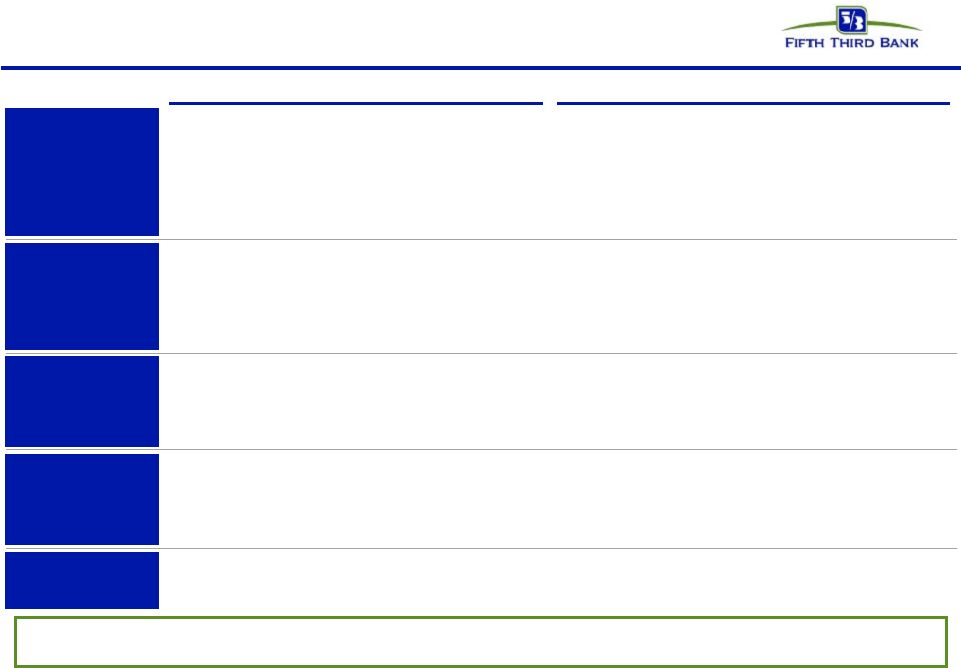 17
©
Fifth Third Bank | All Rights Reserved
Potential impact of key elements of Dodd-Frank Act
and other recent financial legislation*
Scope of activity
Potential impact**
Volcker Rule /
Derivatives
•
Vast majority of derivatives activities are exempted
(FITB generally not a market maker)
•
Any proprietary trading de minimis
•
“P/E”
fund investments ~$100mm (<1% of Tier 1
capital)
•
Expect minimal financial impact from loss of existing
revenue
•
Potentially higher compliance costs despite small levels
of non-exempt activities
Debit
Interchange
(Durbin
Amendment)
•
2010 debit interchange revenue of $204mm
•
2010 debit interchange $ volume: $15.7B
–
Signature $12.2B, PIN $3.5B
–
Signature 347mm, PIN 86mm
•
Fed has proposed limits on debt interchange; proposal
currently out for comment
•
Proposals would apply caps of $0.12 or $0.07 per transaction
(e.g., on volume which in 2010 was 433 million transactions)
•
If proposal implemented as written, we would expect
substantial mitigation of any reduction in revenue through
actions by FITB and competitors to recapture costs of providing
this service to customers and merchants
Deposit
Insurance
•
Current assessed base (Deposits): ~$78B
•
Proposed assessed base (Assets-TE): ~$97B
•
FITB rate under new industry assessment, based
upon large bank scorecard, less than rate under old
assessment
•
Lower due to reduced share of assessed base
Reg. E
•
Requires
customers
to
“opt-in”
to
allow
non-recurring
electronic overdrafts (e.g. debit, ATM) from accounts
•
Estimated 4Q10 impact of $17mm ($68mm annualized)
to deposit service charges, before effect of mitigation; in
full run-rate for 4Q10
Potential impact of these and other elements of financial regulatory reform, such as
CFPA activities and many other aspects, are unknown at this time
TRUPs exclusion
(Collins
Amendment)
•
~280 bps of non-common Tier 1 capital in capital
structure
•
>300 bps of non-common Tier 1 currently
–
Expected to be more than needed post-Basel III
•
3-year transition period begins 2013
•
Will manage capital structure to desired composition
* Based on current understanding of legislation. ** Potential impact, as noted
above, is not intended to be inclusive of all potential impacts that may result from implementation of legislation and
does not include benefit of mitigation activities. Please refer also to cautionary
statement. •
2010 debit interchange transaction volume:
433mm |
 18
©
Fifth Third Bank | All Rights Reserved
Mortgage repurchase overview
Demand requests and repurchase losses remain volatile and near-term
repurchase losses are expected to remain elevated
—
Number of outstanding demand requests (units) down 9% from 3Q10,
outstanding demand requests ($) down 13%
Virtually all sold loans and new claims relate to GSEs or GNMA
—
98% of outstanding balance of loans sold
—
92% of outstanding claims
Majority of new claims and repurchase losses relate to 2006 through 2008
vintages
—
75% of new claims for 2010 YTD
Majority of outstanding balances of the serviced for others portfolio relates
to origination activity in 2009 and later
Claims and exposure related to whole loan sales (no outstanding first
mortgage securitizations)
Repurchase Reserves* ($ in millions)
4Q09
1Q10
2Q10
3Q10
4Q10
Beginning balance
$48
$58
$84
$85
$103
Net reserve additions
25
39
19
49
21
Repurchase losses
(15)
(13)
(18)
(31)
(23)
Ending balance
$58
$84
$85
$103
$101
Outstanding Counterparty Claims ($ in millions)
Outstanding Balance of Sold Loans ($ in millions)
GSE
GNMA
Private
Total
2005 and prior
$8,497
$333
$705
$9,535
2006
2,194
71
333
2,598
2007
3,591
105
285
3,981
2008
3,746
847
-
4,593
2009 and later
25,355
7,173
-
32,527
Total
$43,382
$8,529
$1,323
$53,234
* Includes reps and warranty reserve ($85mm) and reserve for loans sold with
recourse ($16mm). |
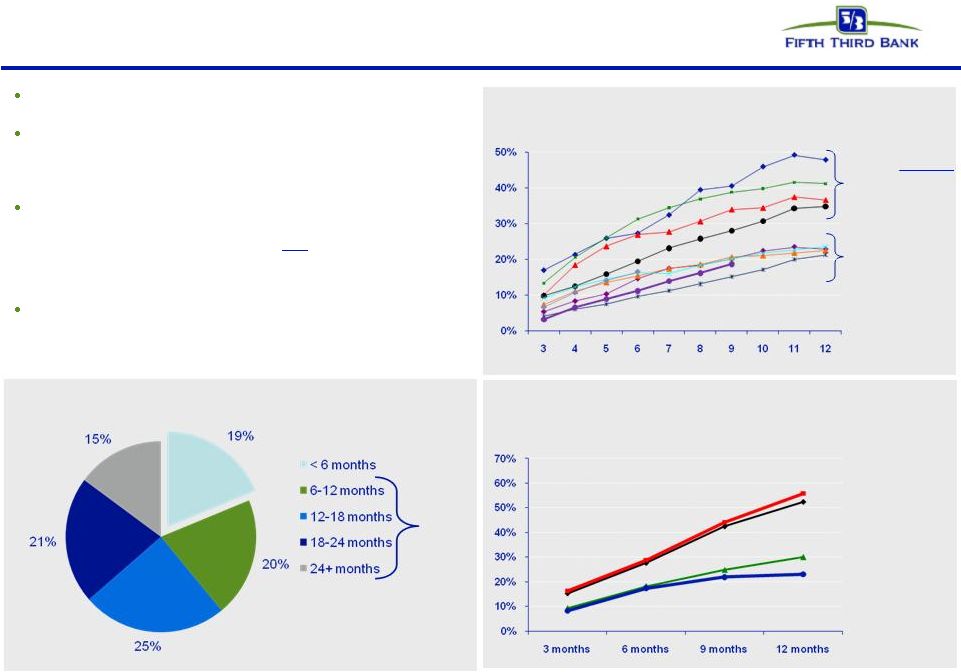 19
©
Fifth Third Bank | All Rights Reserved
Troubled debt restructurings (TDR) overview
Successive improvement in vintage performance during 2008
and 2009, even as volume of modification increased
Fifth Third’s mortgage portfolio TDRs have redefaulted at a
lower rate than other bank held portfolio modifications
—
Fifth Third’s TDRs less likely to redefault than
modifications on GSE mortgages
Of $1.8bn in consumer TDRs, $1.6bn were on accrual status
and $206mm were nonaccruals
—
$1.1bn
of
TDRs
are
current
and
have
been
on
the
books 6 or more months; within that, nearly $800mm
of TDRs are current and have been on the books for
more than a year
As current TDRs season, their default propensity declines
significantly
—
We see much lower defaults on current loans after a
vintage approaches 12 months since modification
TDR performance has improved in newer vintages
Outperforming redefault benchmarks
Source: Fifth Third and OCC/OTS data through 3Q10
Mortgage TDR 60+ redefault trend by vintage
1Q08 $55
2Q08 $114
3Q08 $112
4Q08 $128
1Q09 $189
2Q09 $219
Months since modification
Mortgage TDR 60+ redefault rate: Fifth Third comparison
(January 1, 2008 through September 2010)
Fannie Mae
Industry
portfolio loans
Fifth Third
Volume by
vintage ($mm)
Freddie Mac
3Q09 $269
Current consumer TDRs (%)
4Q09 $137
$1.1bn
2008
2009
1Q10 $131
2Q10 $105 |
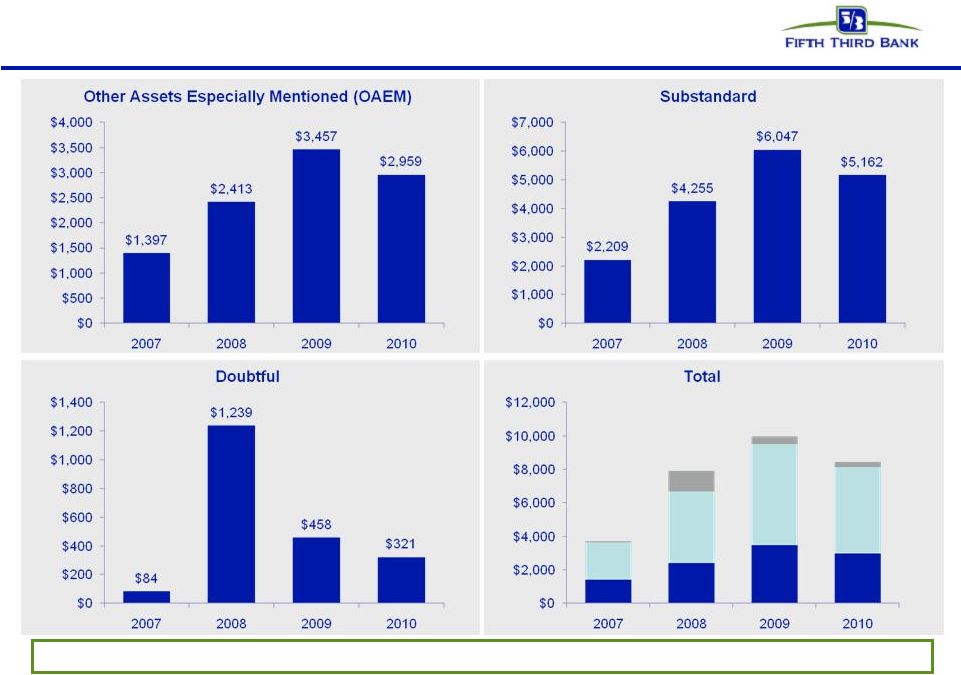 ©
Fifth Third Bank | All Rights Reserved
Criticized / Classified commercial assets
$3,690
$7,906
$9,961
$8,442
Criticized assets have declined significantly in all categories since the peak in
2009 * Criticized / Classified assets also include $2mm, $9mm, and $2mm of
loss assets in 2007, 2008, and 2009, respectively OAEM
Substandard
Doubtful
20 |
 21
©
Fifth Third Bank | All Rights Reserved
NPL
HFI
Rollforward
Commercial
1Q09
2Q09
3Q09
4Q09
1Q10
2Q10
3Q10
4Q10
Beginning NPL Amount
1,406
1,937
2,110
2,430
2,392
2,172
1,980
1,261
New nonaccrual loans
799
544
832
602
405
310
290
308
Paydowns, payoffs, sales and net other activity
(157)
(190)
(246)
(332)
(425)
(401)
(631)
(169)
Charge-offs
(111)
(181)
(266)
(308)
(200)
(100)
(379)
(103)
Ending Commercial NPL
1,937
2,110
2,430
2,392
2,172
1,980
1,261
1,298
Consumer
1Q09
2Q09
3Q09
4Q09
1Q10
2Q10
3Q10
4Q10
Beginning NPL Amount
457
459
477
517
555
561
550
323
New nonaccrual loans
157
125
160
152
137
205
157
159
Net other activity
(155)
(107)
(120)
(114)
(131)
(216)
(384)
(100)
Ending Consumer NPL
459
477
517
555
561
550
323
382
Total NPL
2,396
2,587
2,947
2,947
2,733
2,530
1,584
1,680
Total new nonaccrual loans -
HFI
956
669
992
754
542
515
447
467
NPL Rollforward
Significant improvement in NPL inflows over past two years
* 3Q10 inflows into NPLs HFS were $217mm, reflecting performing loans moved to
held-for-sale in 3Q10 that were deemed impaired as a result of the decision to sell these loans
*
* |
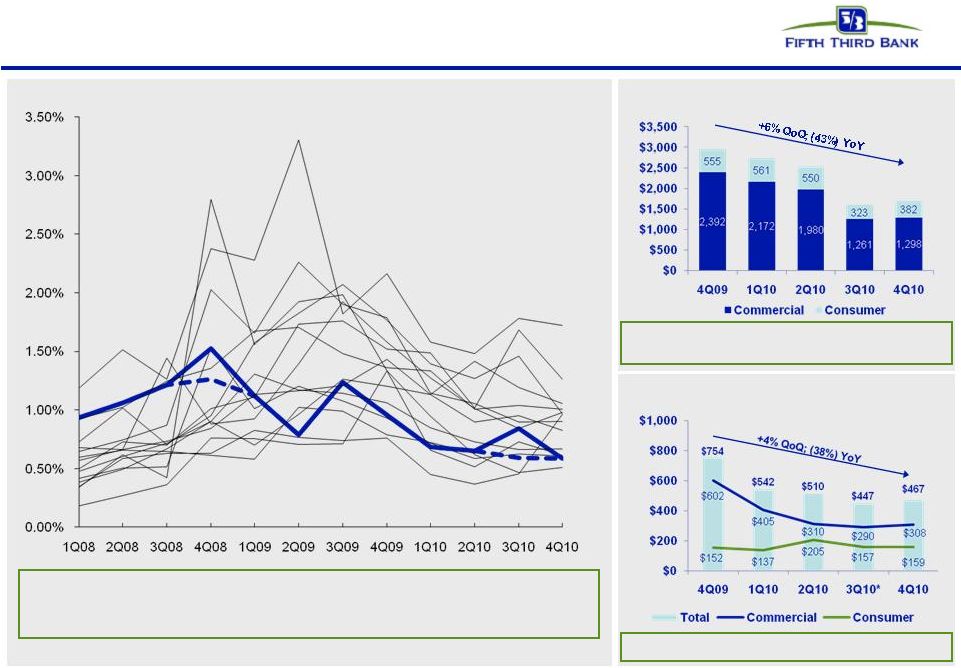 22
©
Fifth Third Bank | All Rights Reserved
Non-performing loans
Non-performing loans ($mm)
Non-performing loans improving with lower
severity mix; benefit of sales/transfers
Fifth Third’s non-performing loan inflows (relative to loans) were higher
than peers throughout 2008. More recently, FITB inflows have been
proportionally lower than peers
FITB NPL inflows (relative to loans) vs. peers
FITB
Source: SNL Financial and company filings. Peers include: BAC, BBT, C, CMA, HBAN,
JPM, KEY, MI, MTB, PNC, RF, STI, USB, and WFC New HFI non-performing loan
flows ($mm) NPL inflows have declined significantly
* 3Q10 inflows into NPLs HFS were $217mm, reflecting performing loans moved to
held-for-sale in 3Q10 that were deemed impaired as a result of the decision to sell these loans
FITB
ex-HFS
$2.9bn
$2.7bn
$2.5bn
$1.6bn
$1.7bn |
 23
©
Fifth Third Bank | All Rights Reserved
Pre-provision net revenue reconciliation
1Q09
2Q09
3Q09
4Q09
1Q10
2Q10
3Q10
4Q10
Reported PPNR
$511
$2,393
$844
$562
$568
$567
$760
$583
Adjustments:
BOLI
54
-
-
-
-
-
(127)
-
Gain on sale of Visa shares
-
-
(244)
-
9
-
-
-
Gain from sale of processing interest
-
(1,764)
6
-
-
-
-
-
Divested merchant and EFT revenue
(155)
(169)
2
-
-
-
-
-
Class B Visa swap fair value adjustment
-
-
-
-
-
-
-
-
Securities gains/losses
24
(5)
(8)
(2)
(14)
(8)
(4)
(21)
Litigation reserve expense
-
-
(73)
22
4
3
-
-
Extinguishment of FHLB funding
-
-
-
-
-
-
-
17
FTPS warrants + puts
-
-
-
(20)
2
(10)
5
(3)
Seasonal pension expense
-
-
10
-
-
-
-
-
FDIC special assessment
-
55
-
-
-
-
-
-
Divested merchant and EFT expense (est.)
49
54
2
-
-
-
-
-
Core PPNR
$483
$564
$539
$562
$569
$552
$634
$576
Credit related items:
OREO write-downs, FV adjs, & G/L on loan sales
3
8
45
31
1
15
42
34
Problem asset work-out expenses
94
57
111
73
91
55
67
53
Credit-adjusted core PPNR
$580
$630
$695
$666
$661
$622
$743
$663 |
 24
©
Fifth Third Bank | All Rights Reserved
Regulation G Non-GAAP reconciliation
Fifth Third Bancorp and Subsidiaries
Regulation G Non-GAAP Reconcilation
$ and shares in millions
Proforma
(unaudited)
CS Issue, TARP
December
December
September
June
March
December
2010
2010
2010
2010
2010
2009
Total Bancorp shareholders' equity (U.S. GAAP)
12,292
14,051
13,884
13,701
13,408
13,497
Less:
Preferred stock
(398)
(3,654)
(3,642)
(3,631)
(3,620)
(3,609)
Goodwill
(2,417)
(2,417)
(2,417)
(2,417)
(2,417)
(2,417)
Intangible assets
(62)
(62)
(72)
(83)
(94)
(106)
Tangible common equity, including unrealized gains / losses (a)
9,415
7,918
7,753
7,570
7,277
7,365
Less: Accumulated other comprehensive income / loss
(314)
(314)
(432)
(440)
(288)
(241)
Tangible common equity, excluding unrealized gains / losses (b)
9,101
7,604
7,321
7,130
6,989
7,124
Add back: Preferred stock
398
3,654
3,642
3,631
3,620
3,609
Tangible equity (c)
9,499
11,258
10,963
10,761
10,609
10,733
Total assets (U.S. GAAP)
111,007
111,007
112,322
112,025
112,651
113,380
Less:
Goodwill
(2,417)
(2,417)
(2,417)
(2,417)
(2,417)
(2,417)
Intangible assets
(62)
(62)
(72)
(83)
(94)
(106)
Tangible assets, including unrealized gains / losses (d)
108,528
108,528
109,833
109,525
110,140
110,857
Less: Accumulated other comprehensive income / loss, before tax
(483)
(483)
(665)
(677)
(443)
(370)
Tangible assets, excluding unrealized gains / losses (e)
108,045
108,045
109,168
108,848
109,697
110,487
Total Bancorp shareholders' equity (U.S. GAAP)
12,292
14,051
13,884
13,701
13,408
13,497
Goodwill and certain other intangibles
(2,546)
(2,546)
(2,525)
(2,537)
(2,556)
(2,565)
Unrealized gains
(314)
(314)
(432)
(440)
(288)
(241)
Qualifying trust preferred securities
2,763
2,763
2,763
2,763
2,763
2,763
Other
11
11
8
(25)
(30)
(26)
Tier I capital
12,206
13,965
13,698
13,462
13,297
13,428
Less:
Preferred stock
(398)
(3,654)
(3,642)
(3,631)
(3,620)
(3,609)
Qualifying trust preferred securities
(2,763)
(2,763)
(2,763)
(2,763)
(2,763)
(2,763)
Qualifying noncontrolling interest in consolidated subsidiaries
(30)
(30)
(30)
-
-
-
Tier I common equity (f)
9,015
7,518
7,263
7,068
6,914
7,056
Common shares outstanding (g)
919
796
796
796
795
795
Risk-weighted assets, determined in accordance with
prescribed regulatory requirements (h)
100,193
100,193
98,904
98,604
99,281
100,933
Ratios:
Tangible equity (c) / (e)
8.79%
10.42%
10.04%
9.89%
9.67%
9.71%
Tangible common equity (excluding unrealized gains/losses) (b) / (e)
8.42%
7.04%
6.70%
6.55%
6.37%
6.45%
Tangible common equity (including unrealized gains/losses) (a) / (d)
8.68%
7.30%
7.06%
6.91%
6.61%
6.64%
Tangible common equity as a percent of risk-weighted assets
(excluding unrealized gains/losses) (b) / (h)
9.08%
7.59%
7.40%
7.23%
7.04%
7.06%
Tangible book value per share (a) / (g)
10.25
9.94
9.74
9.51
9.16
9.26
Tier I common equity (f) / (h)
9.00%
7.50%
7.34%
7.17%
6.96%
6.99%
For the Three Months Ended |
 25
©
Fifth Third Bank | All Rights Reserved
Regulation G Non-GAAP reconciliation
Phase out of TRUPs (TARP, Equity raise)
4Q10
Tier 1 Capital ratio
Tier 1 capital
13,964,857
$
TARP repay
(3,408,000)
$
TRUPs
(2,762,782)
Equity raise
1,648,830
$
9,442,905
$
RWA
100,193,435
$
Asset increase
-
$
100,193,435
$
Tier 1
13.9%
Tier 1 pro forma
9.4% |